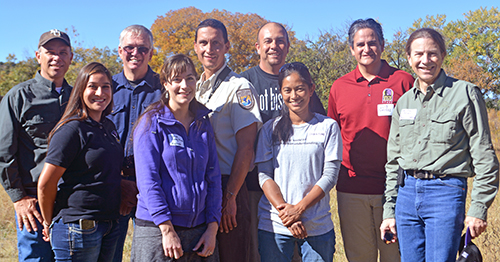
Margaret McKinney/Highlands University
Four entities gathered at the Rio Mora National Wildlife Refuge Oct. 23 to celebrate a unique partnership aimed at bison conservation. From the front left are left Eliza Montoya, Denver Zoo/Highlands biology graduate, Sarah Corey-Rivas, Highlands biology professor, Shantini Ramakrishan, Highlands biology graduate student, and Jim Fries, Highlands president. From the back left are Joe Zebrowski, Highlands Rio Mora liaison, Brian Miller, wildlife biologist, Rob Larrañaga, Rio Mora NWR manager, Phil Viarrial, Pojoaque Pueblo Bison Program director, and Luis Ramírez, Denver Zoo Great Plains program director.
Las Vegas, NM — A Highlands University biology professor’s research to increase the genetic diversity of the bison conservation herd from the Pojoaque Pueblo is part of a partnership that is the first of its kind in the country.
The pueblo is the first tribe in the United States to graze bison on federal land; in this case the Rio Mora National Wildlife Refuge north of Las Vegas. On Oct. 23, the Pojoaque Pueblo, Highlands University, U.S. Fish and Wildlife Service, and Denver Zoo celebrated a partnership focused on bison conservation.
Phil Viarrial, Pojoaque Pueblo Bison Program director, said biology professor Sarah Corey-Rivas’ genetic research is essential for managing the tribe’s bison herd.
“The genetic research that Dr. Sarah Corey-Rivas does is important because it helps us prevent inbreeding in the herd,” Viarrial said. “In our culture, we have a deep respect for bison, and they are extremely important to us for ceremonial and spiritual reasons.
“Historically and currently, bison have nourished Native American people with their meat. Their horns and bones were also used for tools and weapons and their hides were used for shelter and clothing, including costumes for traditional feast days,” Viarrial said.
“Rio Mora National Wildlife Refuge brings people together,” said Rob Larrañaga, manager of the Northern New Mexico National Wildlife Refuge Complex for the U.S. Fish and Wildlife Service. “This historic partnership focuses on long-term bison conservation that honors native cultures and traditions tied to the land.”
North American bison are a species of concern. While more than 30 million bison roamed the Great Plains in the 1800s, only an estimated 29,000 live in the wild today.
Corey-Rivas said that bison help restore healthy grassland ecosystems because the way the animals graze promotes greater diversity in plant species, which in turn increases the diversity of bird species.
“With bison, we’re very concerned about the historic loss of diversity in the species and the unknown consequences,” Corey-Rivas said. “For example, we might have a population of bison that don’t have the genetic immunity to fight disease transmitted by cattle, elk or sheep. Protecting genetic diversity also increases the chances of bison surviving adverse conditions from climate change, such as severe drought.”
For her research, Corey-Rivas collected bison hairs from the herd at Rio Mora National Wildlife Refuge. Then she isolated the bison’s DNA from hair follicles in her Molecular Biology Laboratory at Highlands, involving her students in both elements of the research process.
“We analyze the bison’s mitochondrial genes, which are structures in cells that convert energy for the cell and have their own DNA,” Corey-Rivas said. “We use mitochondrial genes because they give so much information on historic lineages and can also be used to identify bison that are cattle hybrids.”
Corey-Rivas isolated a potentially unique lineage of North American bison through her genetic research on Pojoaque’s herd and will continue to study its pedigree.
Brian Miller, a wildlife biologist and former executive director at Wind River Ranch, was the first to work with the InterTribal Buffalo Council to establish a bison conservation herd at the ranch. Wind River became the Rio Mora National Wildlife Refuge in 2012 — the same year the partnership was formalized.
“It’s critical to know bison lineages for broader conservation of the species across North America,” said Miller, who collaborates with Corey-Rivas on her research. “The research Sarah does is very important because we want to prevent the loss of significant and potentially rare genes that could be crucial to conserving wild bison.”
Other Highlands professors conducting ecology and conservation research at the wildlife refuge include biology professor Jesíºs Rivas and natural resource management professors Edward Martínez, Sara Brown, and Craig Conley.
“Rio Mora National Wildlife Refuge is a very significant site for Highlands University faculty and student research dating back to when it was the Wind River Ranch,” said Jim Fries, Highlands president. “We’re thrilled that this partnership has evolved in a way that supports our university’s research.”
